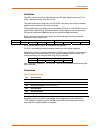
4: Using Setup Mode for Configuration
XPort™ User Guide 39
TCP Keepalive time in seconds
This option allows you to change how many seconds the unit will wait during a silent
connection before attempting to see if the currently connected network device is still
on the network. If the unit then gets no response, it drops that connection.
ARP Cache timeout in seconds
Whenever the unit communicates with another device on the network, it adds an
entry into its ARP table. The ARP Cache timeout option allows you to define how
many seconds (1-600) the unit will wait before timing out this table.
High CPU Performance mode
This option applies to XPort-03 and greater units only. It allows you to increase the
CPU performance and utilize the higher baud rates on the serial interface (i.e.
460Kbps and 920Kbps). Increasing CPU performance requires more power and
lowers the unit’s operating temperature. The standard CPU performance mode
supports up to 230400 baud.
Note: If baud rates of 460Kbps or 920Kbps is set and the high performance mode
disabled, the operation of the serial channel would be out of the specified error
tolerance thereby leading to inconsistent speed settings on the two ends of the serial
channel.
Monitor Mode at Bootup
This option allows you to disable all entries into Monitor Mode during startup, except
for the ‘xxx’ sequence. This prevents entry via ‘yyy’, ‘zzz’, ‘xx1’, and ‘yy1’ key
sequences (only during the bootup sequence). The default for Monitor Mode at
Bootup is enabled. See 7:Monitoring the Network.
HTTP Port Number
This option allows the configuration of the web server port number. The valid range
is 1-65535. The default HTTP port number is 80.
SMTP Port Number
This options allows the configuration of the email port number. The valid range is
from 1-65535. The default SMTP port number is 25.
Note: When configuring the HTTP or SMTP port number, take note of the ‘reserved’
port numbers on page 27.
RS-485 TX Enable Active Level
Note: The following applies to XPort model XP1004000-03 (XPort-485).
This option allows the selection of the active level (either ‘active high’ or ‘active low’)
for the RS485_TXEN signal. The default is ‘active low’.
This setting only applies if one of the configurable pins for the RS485_TXEN
functionality is selected. For the RS-485 interface mode to operate correctly,


















